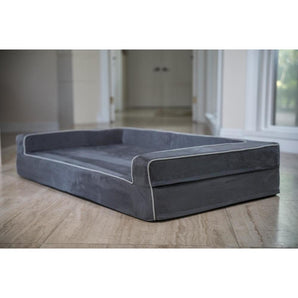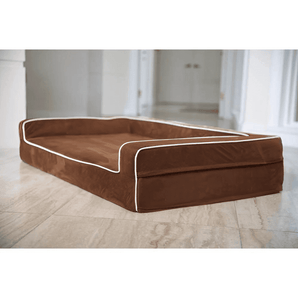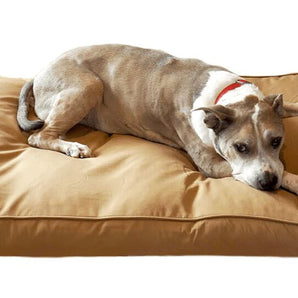Watching your dog slow down is never easy, especially when you know it’s because they’re hurting. If your big pup is moving less, struggling to get up, or skipping their favorite walk, canine osteoarthritis (OA) could be to blame.
Also known as degenerative joint disease, osteoarthritis is one of the most common conditions in senior and large-breed dogs. And while it’s a chronic disease, there are lots of things you can do to manage joint pain and help your dog feel more comfortable.
Let’s take a closer look at what causes OA, how to recognize it early, and what relief options are available to help make sure your dog's life is as pain-free as possible.
What is Canine Osteoarthritis?
Osteoarthritis in dogs is a progressive condition that causes the cartilage in your dog’s joints to break down over time. As the cartilage deteriorates, the bones begin to rub against each other, leading to pain, stiffness, and decreased mobility. This type of joint disease can affect any joint in the body, but it's most common in the hips, elbows, knees, and spine, especially in larger dogs.
Because OA is a chronic disease, it doesn’t go away on its own. But with early intervention and the right management plan, you can decrease inflammation, decrease pain, and help your dog maintain their quality of life.
Common Signs of Joint Disease in Dogs
If your dog is slowing down, it’s easy to chalk it up to age. But don’t ignore the subtle changes—joint disease often starts with small signs that are easy to miss.
Keep an eye out for:
-
Stiffness or limping, especially after rest
-
Difficulty getting up or lying down
-
Reluctance to jump, run, or climb stairs
-
Swelling in affected joints
-
Licking or chewing at specific areas
-
Behavior changes like irritability or withdrawal
-
Muscle loss in the legs or back end
If your dog shows any of these signs, talk to your vet. A physical exam and imaging tests can help confirm canine osteoarthritis and rule out other possible causes of pain.
Causes and Risk Factors for Canine OA

There’s no single cause of osteoarthritis in dogs, but there are several risk factors that can increase the chances of developing osteoarthritis—especially in large and giant breeds that carry more weight on their joints.
Hip and Elbow Dysplasia
Hip dysplasia and elbow dysplasia are among the most common genetic contributors to OA. These conditions cause the joints to form abnormally, which leads to uneven wear, instability, and early breakdown of cartilage. Over time, this abnormal movement leads to degenerative joint disease, especially in affected joints like the hips, elbows, and knees.
Injuries
Injuries are another major player. If your dog has experienced a torn ligament (like a CCL), joint dislocation, or fracture, those areas are much more likely to develop arthritis later. That’s because the joint disease process is often triggered when the body tries to heal or compensate, which can increase pressure or change the way your dog’s joints move.
Additional Risk Factors
Other risk factors include obesity, which puts added strain on every step your dog takes, and poor nutrition, which can lead to weaker cartilage and bone. Dogs involved in high-impact sports or intense activity may also be more prone to joint wear, especially if they’re jumping or running on hard surfaces. And of course, aging plays a role—just like humans, older dogs are more likely to experience joint pain as their cartilage naturally wears down over time.
There’s also an emerging focus on nerve growth factor (NGF)—a protein that ramps up pain signaling in the nervous system. When NGF levels rise in the joint, it can worsen OA pain and sensitivity. That’s why some newer pain medications are designed to target NGF directly, offering a promising option for pain management in dogs with severe osteoarthritis.
How to Manage Pain For Dogs With Osteoarthritis
If it's left untreated, OA can make it painful for your dog to move at all, causing them to lose muscle mass and mobility. Luckily, today’s treatment options for osteoarthritis in dogs are more effective than ever.
A complete plan might include a mix of:
-
Pain medications prescribed by your vet
-
Joint supplements to support cartilage health
-
Lifestyle changes like weight management and regular, low-impact exercise
-
Therapeutic exercises to build strength and flexibility
-
Orthopedic bedding to reduce joint pressure during rest
-
Advanced options like laser therapy, joint injections, or even surgical intervention for severe osteoarthritis
At-Home OA Management for Dogs
With a few small changes, you can create a comfortable, supportive environment that helps decrease pain, preserve mobility, and slow the progression of this chronic disease.
Orthopedic Bedding
When a dog is dealing with joint pain, where they sleep matters more than you might think. A supportive surface helps reduce pressure on joints, especially during long periods of rest, which can go a long way in easing discomfort, particularly in dogs with degenerative joint disease, hip dysplasia, or elbow dysplasia.
For large and extra-large dogs, choosing a bed that doesn’t flatten under their weight is key. Orthopedic dog beds made with high-density memory foam can help cushion affected joints, promote better alignment, and support sore muscles. Some dogs prefer beds with built-in headrests for extra neck support, while others might need something more durable if they tend to chew or dig at their bedding.
If you're looking for a bed that checks all those boxes, Bully Beds offers several orthopedic options designed with big dogs and severe osteoarthritis in mind, including dog beds with bolsters for head support and chew-resistant dog beds for rougher sleepers.
Regular Exercise
It might seem counterintuitive, but rest alone isn’t the answer for managing osteoarthritis in dogs. Regular exercise is key to preserving muscle mass, keeping joints mobile, and improving overall function. Just like in people, movement helps lubricate your dog’s joints and can actually help decrease pain over time.
That said, it’s important to tailor exercise to your dog’s ability. Short, low-impact walks, gentle fetch in the yard, or even simple indoor stretching routines can go a long way. Avoid high-impact movements like jumping on and off furniture, chasing balls up stairs, or running on slick surfaces. For the best results, ask your vet or a canine rehab specialist to recommend therapeutic exercises based on your dog’s condition.
Weight Management
Carrying extra weight puts serious strain on your dog’s joints, especially in the hips and elbows. Helping your dog maintain a healthy weight is one of the best ways to slow the progression of a degenerative joint disease and improve overall comfort.
Joint Supplements
Joint supplements can be a powerful part of your dog’s at-home arthritis management plan. While they don’t work overnight, consistent use can help decrease inflammation, support cartilage health, and reduce stiffness in your dog’s joints over time.
Look for supplements containing glucosamine and chondroitin, which support joint structure and repair. Omega-3 fatty acids (like those from fish oil) have anti-inflammatory effects, while ingredients like green-lipped mussel, MSM, turmeric, and hyaluronic acid offer additional support for pain management. Always choose veterinarian-approved supplements formulated specifically for dogs, and make them a regular part of your dog’s daily routine.
Medical and Vet-Prescribed Treatments For Dog Osteoarthritis
Depending on the severity of your dog’s symptoms and their overall health, medical management options may include prescription pain medications, joint injections, physical rehabilitation, or even surgical intervention.
Prescription Medications for Pain Relief
Many dogs with degenerative joint disease benefit from pain medications prescribed by their vet. These may include NSAIDs to reduce inflammation, as well as newer drugs that target nerve growth factor for longer-lasting relief.
Joint Injections or Laser Therapy
For severe osteoarthritis in dogs, joint injections can provide direct, targeted relief in affected joints. Another non-invasive option is laser therapy, which can help decrease inflammation, increase circulation, and promote healing at the cellular level.
Physical Therapy or Hydrotherapy
Physical rehabilitation—like guided stretching, therapeutic exercises, or hydrotherapy—can improve mobility and reduce discomfort. Water therapy is especially helpful for large dogs, as it allows for low-impact movement without added stress on your dog's joints.
Surgical Intervention
When other treatments aren’t enough to relieve the pain of osteoarthritis in dogs, surgical intervention may be recommended. Options vary depending on the joint involved and your dog’s overall health, but they may include joint replacement, arthroscopy, or corrective procedures for hip dysplasia or elbow dysplasia.
Keep Your Senior Dog Comfortable With Bully Beds Orthopedic Dog Beds

With the right mix of pain control, supportive care, and a few lifestyle changes, you can help your furry friend feel better and stay mobile for many years.
At Bully Beds, we’re proud to support dogs with joint disease by providing orthopedic beds that are made to last. Whether your dog is recovering from surgery, dealing with chronic OA pain, or just needs a little extra support, our beds are here to help them rest easy and wake up ready for the day.





